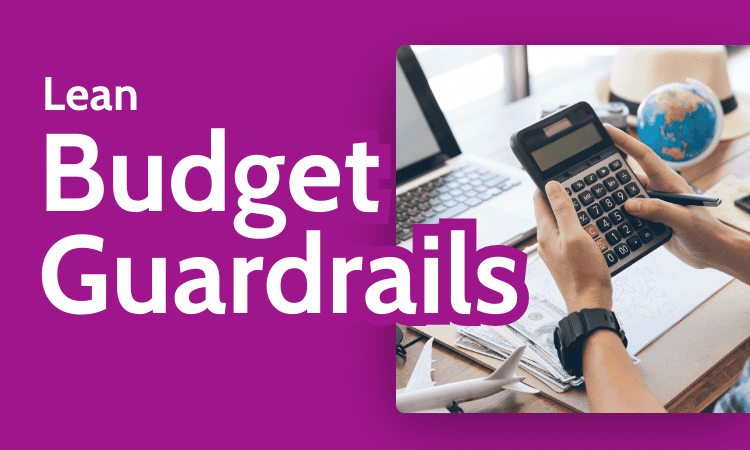
Controlling budgets for projects big and small can be challenging, even with the best project management software at your disposal. Unfortunately, budget control is even trickier when using scaled agile frameworks like SAFe. Lean budget guardrails in SAFe not only help you control your budgets but also improve customer value, throughput and your value stream.
What sets Lean budgeting apart from traditional accounting methods is the fact that Lean budgets allocate funds to each project before it starts, but those budgets can be adapted to suit changing markets and customer requests. In contrast, traditional accounting sets project budgets for an entire year and finds them hard to change in response to new demands.
In this guide, we’ll discuss Lean budget guardrails and how they can assist in controlling budgets. We’ll also explore the advantages of the Lean budgeting method over traditional budget controls. By the end, you’ll better understand how Lean budgets can help organizations align strategic objectives with project budgets, which should bring a smile to your CFO’s face.
Learn more about our editorial team and our research process.
What Are Lean Budget Guardrails in Lean Portfolio Management?
Lean budget guardrails are financial guidelines and policies used in Lean portfolio management (LPM) — a key component of SAFe. The guidelines and policies help enhance company operations by providing structure around direct spending, which involves purchasing goods (materials, equipment and supplies) for a project.
Aligning resource allocation with the company’s projected expenditures can optimize an organization’s return on investment (ROI). In addition, Lean budgeting increases transparency and accountability through using evaluation criteria. It also makes traditionally rigid project budgets more agile and adaptable to organizational and market fluctuations.
The Four SAFe Lean Budget Guardrails Explained
Lean budgeting is similar to Lean project management. The idea is to evaluate systems and cut unnecessary steps to make processes more efficient and affordable. Once financial evaluations take place and a project’s financial framework is determined, you can allocate an appropriate amount of money for a project to foster innovation and productivity.
To build a financial framework for a project portfolio, a project manager, Scrum Master or financial manager can evaluate a project using four Lean budget guardrails. We’ll examine these guardrails below.
What Is Gained by Establishing Lean Budget Guardrails?
Lean budget guardrails bring much-needed financial structure and governance to projects. They help ensure that value streams (the activities that make up the project) create maximum value for investors, clients and project stakeholders. Below, we’ll look at the benefits of employing this agile accounting method.
- Accountable spending management: When implemented correctly, guardrails in LPM increase financial accountability. Teams know they can spend wisely to a point, but must seek approval to breach the portfolio epic threshold.
- Risk management: Lean budgeting can help project leaders manage risk. By allocating capacities to time horizons, teams can limit the risk of overspending.
- Strategic alignment: Maintaining alignment between business strategies and customer demands is the critical function of Lean budgeting.
- Agility and flexibility: Unlike traditional accounting methods, which set budgets for an entire fiscal year, Lean budgeting allocates budgets to each project portfolio. It allows teams to adapt budgets to changing markets and customer requests.
How Do Lean Budget Guardrails Reduce Risk?
Project managers can mitigate risks by implementing Lean budget guardrails in numerous ways. These methods include the following:
- Large initiative oversight: The approval process for spending over the set limit helps increase accountability and lowers financial risk.
- Budget tracking: Monitoring time horizons and their budgets helps project leaders notice financial irregularities early, which can lead to timely corrective action.
- Financial transparency: Well-defined policies and the continuous involvement of business owners, investors and stakeholders will ensure financial transparency. At every point, any project member can see financial information and address issues before they become critical.
- Continual engagement: Frequent meetings with stakeholders and clients allow the entire internal and external project team to discuss risks and formulate plans to address them should they arise.
What’s the Advantage of Lean Budget Guardrails vs Traditional Methods?
The biggest advantage of Lean budgeting compared to traditional project-based funding is flexibility. Traditional accounting methods allocate budgets for an entire year based on the previous year’s expenditures. This method is inflexible and doesn’t consider changing customer demands or industry and market changes.
Lean budgeting accounts for customer requirements, systems, processes and markets for every project portfolio. After careful analysis, financial frameworks for individual projects are set. This ensures that projects have enough capital to deliver what the customer needs while remaining true to company strategies and objectives.
Final Thoughts
Lean budgeting guardrails — a key component of budget management in SAFe — allow teams to remain financially agile throughout a project’s lifecycle. In addition, continued oversight helps projects avoid scope creep by ensuring that finances are allocated smartly to different focus areas and by requiring approval for any initiatives that will break set budgets.
Implementing Lean budgeting holds teams financially accountable and delivers maximum value to clients and investors. Do you use the SAFe method? Have you found that Lean budget guardrails help keep projects on track? What project management software do you use to track finances? Let us know in the comments. Thanks for reading.
FAQ: Lean Budget Guardrails
-
A Lean budget guardrail is a practice or policy that helps control budgeting, spending and governance of project portfolios.
-
The first Lean budget spend guardrail is to guide investments by horizons. The other guardrails include applying capacity allocation to optimize value, approving significant initiatives and continuous business owner engagement.
-
Lean budget guardrails help organizations reduce waste and align company goals with organizational budgets.
The post Lean Budget Guardrails: Definition, Advantages & FAQ in 2024 appeared first on Cloudwards.



